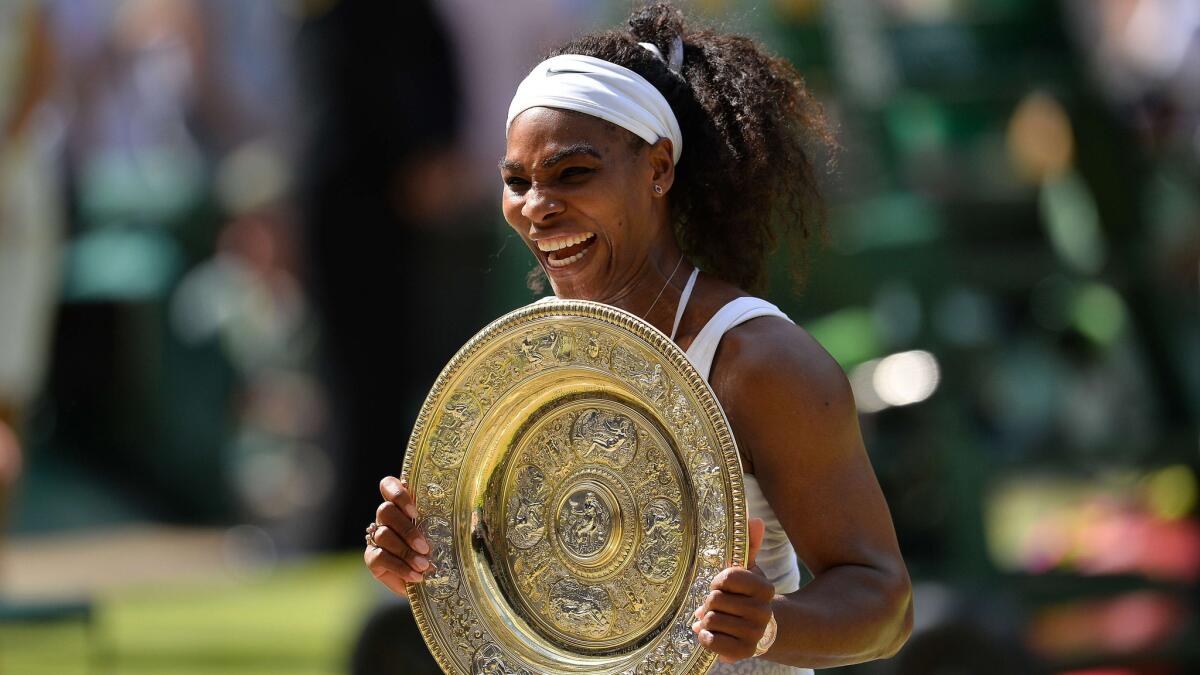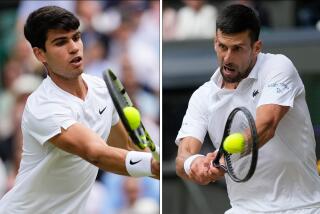Column: Serena Williams wins Wimbledon; next stop, New York in her Grand plan

Serena Williams celebrates with the winnerâs trophy, the Venus Rosewater Dish, after defeating Garbine Muguruza for the Wimbledon singles title on Saturday.
From London â Start spreading the news.
New York is now the next stop on the Serena Williams tour of tennis grandeur.
There is no question that she can make it there, at the U.S. Open, the final Grand Slam tournament of the year, because in a tennis career that has carried on for 17 years, she has made it everywhere.
Saturdayâs 6-4, 6-4 victory over Garbine Muguruza in the Wimbledon final unleashed a load of statistical updates and numerical superlatives.
Williams completed what is known as the âSerena Slam.â
There are four major tournaments on the tour and she has now won four in a row. She is the only womenâs player to do that twice, having also run off four in a row starting with the 2002 French Open. Martina Navratilova did it starting with Wimbledon in 1983 and Steffi Graf starting with the French in 1993.
But those achievements spanned two separate years. The bigger deal is a calendar-year Grand Slam, and thatâs what will be making big headlines in New York City, where the Open begins Aug. 31.
That feat has been accomplished by Maureen Connolly in 1953, Margaret Court in 1970 and Graf in 1988, the same year she also won an Olympic gold medal and went on to win the following yearâs Australian Open.
Not a bad run. Nor is the one Williams is on now.
She came to last yearâs U.S. Open after disappointing early losses at the previous three majors. She won there and has not looked back.
When she gets to the U.S. Open, which she has won six times, Williams can do what hasnât been done since Graf 27 years ago. She can also tie Grafâs open-era record of 22 major titles. Thatâs two behind Courtâs 24, more than half of those accumulated before tennisâ all-professional tour began in 1968.
Interestingly, New York might reserve a headline or two for Saturdayâs runner-up.Muguruza, a 21-year-old Spaniard, made the final a fascination. Williams won, but a star was also born on the other side of the net.
Muguruza came here with little chance of making the final. She was nowhere in the top 100 two years ago, and was No. 20 here. But she is from Spain, where playing tennis on grass, rather than clay, is sneered at and where Rafael Nadalâs occasional success at Wimbledon is considered both a tribute to him and a fluke of nature.
âI came here last year,â Muguruza said, âbut I didnât like grass.â
This year was different.
âThis year, I came, thinking, I like grass.â
But liking grass, and playing Serena Williams and her history of five previous titles on it here, were two entirely different things. Muguruza was between a longshot and a no-chance.
But a funny thing happened on the way to the thrashing. Muguruza answered Williamsâ hard hitting with her own, and got to 3-1 and 4-2 leads in the first set.
Williams, of course, figured it out, started overwhelming Muguruza, and soon had not only won the set, 6-4, but had run off to a 5-1 lead in the second.
On the womenâs tour, this is where 95% of opponents look at Williams and start mentally packing their bags. Not Muguruza.
Williams served for the match at 5-1. Muguruza broke her at love.
Williams served for the match at 5-3. She got a match point, but Muguruza hit the chalk with a cross-court forehand. On her fifth break point, Muguruza hit a forehand winner and was back on serve at 4-5.
The Centre Court crowd loved it. Their emotions, if neither a Brit nor Roger Federer is involved, are driven by backing the underdog and rooting for a longer match. This was somehow different.
The 15,000 strong had in front of them a hopeless underdog, outclassed by 20 Grand Slam victories, by 20 spots in the rankings and by 13 years of age and experience.
But Muguruza kept getting off the mat, and the Brits were going wild.
In her on-court interview afterward, Muguruza told the crowd, âI am proud to play in front of you.â To the media later she said, âI think they saw in me that I really wanted to win . . . that I give everything to tennis. They like when they see someone fighting so much to win.â
At 4-5 of the fight, Williams had had enough. Muguruza started with a double fault and now there were more butterflies than fight. Williams got a cheapie off the net cord for love-30, Muguruza hit a backhand long and now faced three match points. She went meekly on the first one, hitting wide.
The appreciation for this newfound battler flowed over into the awards ceremony. The Brits always feel sorry for the losers at these times, but the standing ovation indicated that Muguruza would be more than a quickly forgotten name on a list of also-rans to Williams.
âI couldnât stop crying,â Muguruza said later. âSo many people are clapping. . . . I make all these people feel this in a tennis court?â
Even Williams stood and applauded from her chair, then told Muguruza, âDonât be sad. Youâll be holding one of these [trophies] soon.â
Muguruza, a news conference delight with a rare streak of candidness, was asked about Williamsâ on-court comment.
âItâs good when you hear something like this from a legend,â she said, âbut at that moment, I was like, ya, ya.â
Williams said she served poorly, but she still hit 12 aces. She had 29 winners and had a top service speed, several times, of 123 mph. In his semifinal victory over Andy Murray on Friday, Federerâs top service speed was 126.
Williams said she was still letting the moment settle in. She said she would be ready for New York and the attention and pressure that will hit her there.
âI feel like, if I can do the Serena Slam,â she said, âIâll be OK heading into the Grand Slam.â
And so it will be, Serena Williams in the Big Apple, wearing those vagabond shoes.
Twitter: @DwyreLATimes
More to Read
Go beyond the scoreboard
Get the latest on L.A.'s teams in the daily Sports Report newsletter.
You may occasionally receive promotional content from the Los Angeles Times.











